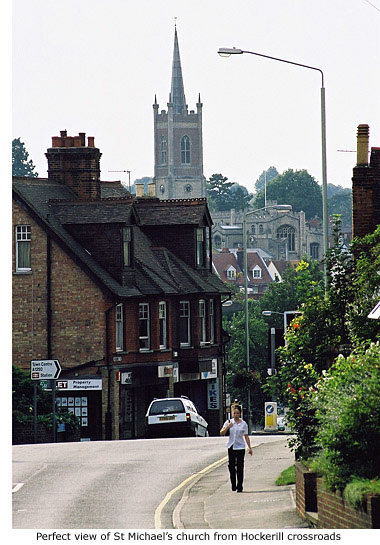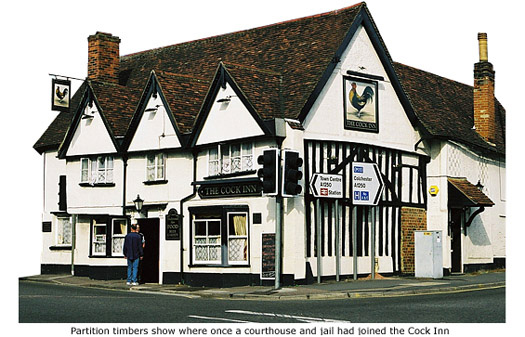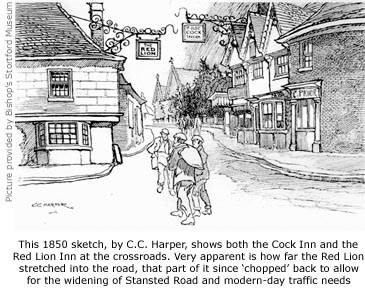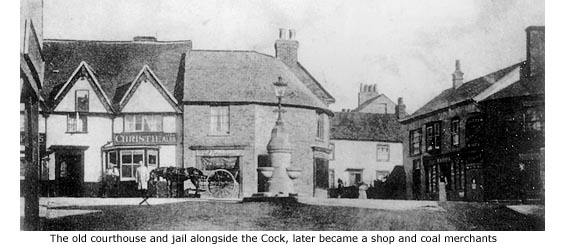|
 Of the thousands of people who pass through Hockerill crossroads every day, very few will have any knowledge of the marvellous history associated with this small area. For most it's just another obstacle delaying their car journey, but between the 17th and 19th century, even though the mode of transport was somewhat different, this junction was an equally busy place. Of the thousands of people who pass through Hockerill crossroads every day, very few will have any knowledge of the marvellous history associated with this small area. For most it's just another obstacle delaying their car journey, but between the 17th and 19th century, even though the mode of transport was somewhat different, this junction was an equally busy place.
It all started in the early 1600s when a long-distance passenger coach service began running between London and Bishop’s Stortford. As more and more travellers ventured out from the city the town’s popularity and prosperity grew tenfold, but the increase in traffic in an already busy town centre was not welcomed by all. Charles II, a regular passer-by on his way to Newmarket races, hated it and prompted the Royal Surveyor to find an alternative route. The result, in 1670, was construction of the Hockerill bypass (See Guide 12) but as more and more traffic began to use it, so the town’s traders suffered and many went out of business.
In complete contrast, the three inns sited at Hockerill’s crossroads were rewarded with fame and fortune and very soon a fourth inn was built, creating one on each corner. The main road disecting the crossroads, now designated the B1383, was one of the principle routes between London and East Anglia, the fastest stagecoaches taking only 3–4 hours to reach Hockerill from London. It made it a convenient place for a change of horses and for passengers to eat a meal or stay overnight.
In 1815, eight or nine stagecoaches passed through Hockerill and Bishop's Stortford to and from London every day, calling at Bury St Edmunds, Norwich, Newmarket, Cambridge, king's Lynn, Fakenham, Saffron Walden, Haverhill and other towns. Most of these stopped at Hockerill, with only one or two travelling through the town to stop at the King's Head and the George. At this time the Royal Mail coach to Norwich also passed through Hockerill, dropping and collecting letters at the Coach and Horses. In addition, there were two Stortford based coaches, one owned by Henry Gilbey the other by William Low (See Guide 4).
It seemed the place never slept, and as Hockerill’s prosperity continued into the 19th century, Sir Walter Gilbey, who lived at the Red Lion Inn as a boy, commented in later life that it was so busy ‘Sunday never came’.
By the 1930s, roads were rapidly becoming more and more congested by an increasing number of cars, buses and lorries, and traffic related accidents were becoming commonplace. All crossroads were dangerous to negotiate but Hockerill crossroads was a particularly busy junction, especially during peak times. The person elected to stand in the middle of these crossroads and sort it all out each day was generally an AA patrolman, but these duties were finally ended when traffic lights were installed in 1933. Ceremoniously switched on, on Thursday 29 June (at 11am precisely), they were automatically controlled by the flow of traffic passing over rubber strips laid on the road, but only operated between the hours of 6am and midnight – the electricity being switched off at this time! MORE PICTURES
|
|

 Of the four inns that once traded here the Cock is the oldest and the only one still in business. Constructed around 1547, it has been a tavern since 1620 and was first known as the Black Lion. In 1749 it was renamed the Vernon’s Head (see below) and at some later date, the Cock Inn. In coaching days, attendants and servants of ‘notable’ travellers would lodge at the Cock Inn while their employers stayed at the more salubrious Crown Inn or Red Lion Inn that stood opposite. Of the four inns that once traded here the Cock is the oldest and the only one still in business. Constructed around 1547, it has been a tavern since 1620 and was first known as the Black Lion. In 1749 it was renamed the Vernon’s Head (see below) and at some later date, the Cock Inn. In coaching days, attendants and servants of ‘notable’ travellers would lodge at the Cock Inn while their employers stayed at the more salubrious Crown Inn or Red Lion Inn that stood opposite.
Timber-framed with three gables and crooked windows, and almost 500 years old, the inn has obviously had to undergo some alteration and modernisation, but this is minimal. In an upstairs landing is said to be a priest’s hiding hole – a secretive place built into the fabric of many such buildings at the time of the Reformation – and this one may well have been used in the 18th century by the notorious highwayman, Dick Turpin. He struck fear into the hearts and minds of many wealthy travellers on this route and is supposed to have often used this inn as a place to rest and, no doubt, count his stolen money.
A faded poster on the wall of the bar reads: ‘Wanted. Knowne highwayman and rogue, Dick Turpin. For robberie and grievous offence upoune travellers on ye London to Cambridge coach. He has been espied in company at ye Cock Inn’. Had he been caught at the inn, a prison cell wasn’t very far away. Like many inns of that time the Cock was also used as a courthouse and jail, both housed in a part of the building that adjoined its south side.
It's doubtful that any prisoners were held or tried here in the 19th century and the courthouse and jail eventually housed a shop and a coal merchants, both surviving until the 1960s. At that time local planners put forward a road widening scheme to improve the junction by demolishing the Cock, but at the ensuing public inquiry the inn was saved and in 1965 only the former courthouse and jail was taken down. The timber framework that supported the wall between the inn and the courthouse now forms the Cock's exterior wall facing Dunmow Road.
 The inn also holds a replica of the Key of Hockerill – a larger than life key weighing some 50lbs – the original of which may well have been a symbolic key of justice associated with the inn’s old courthouse. In the 19th century, however, it became the symbol of a humorous society known as the Hockerill Club, founded by Samuel Game – harness maker of Hockerill – and Duke Newton.
The inn also holds a replica of the Key of Hockerill – a larger than life key weighing some 50lbs – the original of which may well have been a symbolic key of justice associated with the inn’s old courthouse. In the 19th century, however, it became the symbol of a humorous society known as the Hockerill Club, founded by Samuel Game – harness maker of Hockerill – and Duke Newton.
On becoming a member of the club it was customary for a man to buy a round of drinks for all the other members, and he was led to believe that membership would relieve him from the necessity of paying tolls on the highways. The fact was, the member himself was indeed exempt, but whatever mode of transport he was using when he came to a toll, wasn’t!
The original home of the key was at the Crown Inn, but for some unknown reason during the mid 1800s it was transferred to the Cock under armed guard aboard a dung cart. The distance between the inns is only a matter of yards, but at some point between the two it mysteriously disappeared and some time later turned up in Cambridge. Its new owner was then ‘gracious’ enough to allow a replica key to be made at Hughes Foundry in the Causeway, but it seems more than one key was made.
What was thought to be the replica key disappeared several times in the years that followed, but was eventually recovered and kept first at the Chantry then, later, chained to the wall of the public bar in the Coach & Horses Inn, Hockerill. But the chain proved no deterrent and in 1975 the key was stolen yet again. It was eventually found but a similar key to that held at the Cock is also held by the Working Men's Club at South Street. MORE PICTURES
|
|

In 1739, Admiral Edward Vernon (1684–1757), with just six ships under his command, took the Spanish held port of Portobelo in the West Indies, destroying all military installations there. When news of this reached England it was hailed a spectacular victory and many landlords commemorated the event by renaming their pub The Vernon's Head. It would seem, though, that good news took a little longer to reach Bishop’s Stortford: the Cock Inn (then the Black Lion) not being renamed The Vernon’s Head until ten years after the event.
|

